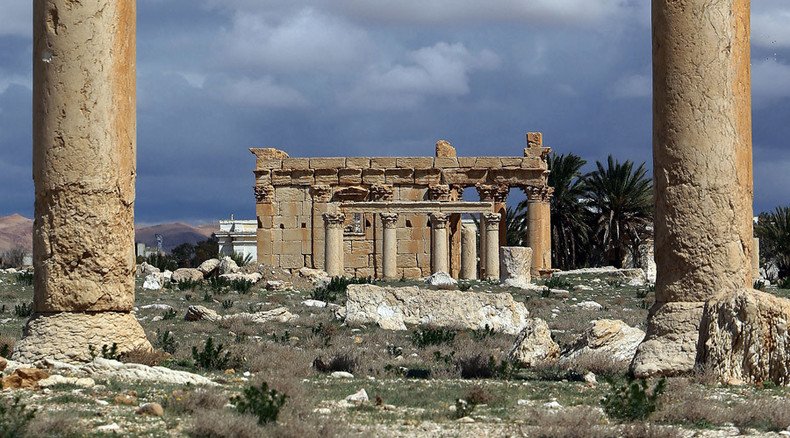Harrowing images show ISIS ‘demolishing’ Syria’s ancient Palmyra temple (PHOTOS)

Islamic State militants have released photos showing what appears to be the destruction of the ancient Baal Shamin temple in Syria's Palmyra, a UNESCO World Heritage Site recently captured and vandalized by the jihadists.
The militants on Tuesday published images purporting to show men carrying barrels with what seemed to be explosives into the Baal Shamin temple in Syria's Palmyra. The series of photos also depicted barrels tied to the columns of the temple and a large explosion which razed the building to the ground. The images were presumably screenshots from a video.
The Baal Shamin temple, which used to be the best preserved building at Palmyra, was blown up on Sunday, according to officials. UNESCO said that its inner part – or cella – was “severely damaged” and the surrounding pillars collapsed after the explosion.
#IslamicState releases photos from demolition of Baal Shamin temple in Palmyra #Syria. |
Savages. pic.twitter.com/tPXku5Y2H7
— Yannis Koutsomitis (@YanniKouts) August 25, 2015The temple dedicated to a Semitic deity was built nearly 2,000 years ago and further enlarged by Roman Emperor Hadrian in the 2nd century AD.
READ MORE: ISIS blows up ancient Baal Shamin temple at Syria’s Palmyra
The act sparked international condemnation with the UN calling it a war crime.
“Such acts are war crimes and their perpetrators must be accountable for their actions. UNESCO stands by all Syrian people in their efforts to safeguard their heritage, a heritage for all humanity,” said the UNESCO Director-General Irina Bokova.
BREAKING: Islamic State terrorist publishes pictures of blowing up 2000 year old Baalshamin temple in #Palmyra#Syriapic.twitter.com/7bjC9YX40p
— News_Executive (@News_Executive) August 25, 2015Palmyra, an “oasis in the Syrian desert” located northeast of Damascus, contains the ruins of an ancient city built in the 1st and 2nd centuries AD that was once one of the most important cultural centers located on the cross roads of several civilizations. The architecture of the city presented a unique combination of Greco-Roman techniques with Persian influence. The discovery of Palmyra in the 17th and 18th centuries significantly influenced the development of architectural styles.
The temple of Baalshamin in Palmyra before & after the Islamic State blew it up #Palmyra H/t @MsInterventionpic.twitter.com/1rwYwUHmpp
— Tom Holland (@holland_tom) August 25, 2015“The art and architecture of Palmyra, standing at the crossroads of several civilizations, is a symbol of the complexity and wealth of the Syrian identity and history,” said Bokova.
“Extremists seek to destroy this diversity and richness, and I call on the international community to stand united against this persistent cultural cleansing. Daesh [an Arabic name for Islamic State or IS, formerly ISIS/ISIL] is killing people and destroying sites, but cannot silence history and will ultimately fail to erase this great culture from the memory of the world. Despite the obstacles and fanaticism, human creativity will prevail, buildings and sites will be rehabilitated, and some will be rebuilt.”
The destruction of the temple comes a week after Palmyra's 82-year-old retired antiquities chief Khaled Asaad was beheaded by the jihadists after being reportedly tortured and questioned for a month about the location of valuable artifacts. He worked at the cultural site for more than 50 years.
“They killed him because he would not betray his deep commitment to Palmyra,” Bokova said. “They murdered a great man, but they will never silence history.”
READ MORE: ISIS beheads 82yo chief of antiquities in ancient Palmyra – senior Syrian official
Before Palmyra was captured by IS on May 21, 2015, officials managed to remove some precious artifacts from the site transporting them to Damascus. In June the extremists decimated two unique tombs in Palmyra.
IS militants have previously captured and destroyed a number of cultural sites in Iraq, including the historic Assyrian city of Nimrud, the ancient city of Hatra, the tomb of the Prophet Jonas, and the museum and Public Library in Mosul.
READ MORE: Appalling ISIS video shows ancient Assyrian city of Nimrud being razed to ground
The jihadists have previously said they consider the artifacts idolatrous. The militants have been waging a campaign to obliterate cultural sites and relics, which do not fall in line with their ideology on the territories of the self-proclaimed caliphate in northern Iraq and parts of Syria.
LISTEN MORE:












